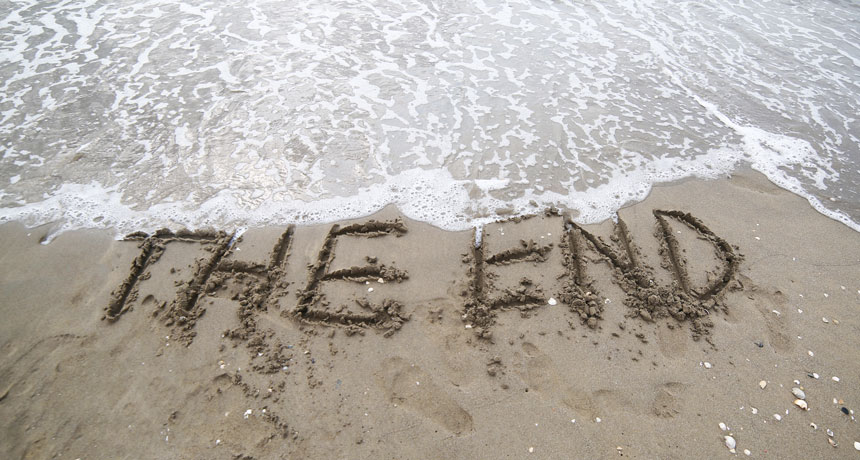This blog is dead. Long live the blog.
This will be the last post from Scicurious

This blog is washing away, in the high tide of the internet. But the definition of a blog? That’s just a line in the sand.
ChiccoDodiFC/shutterstock
- More than 2 years ago
To blog, or not to blog?
Young scientists and aspiring writers and communicators ask me this question frequently. If they want to try their hand at science writing, science communication and science journalism, shouldn’t they start a blog? Shouldn’t they start producing content immediately? After all, the best way to learn to write is to write.
I understand why they think starting a blog is the thing to do. That’s what I did. In 2008, while I was getting my Ph.D., I started a blog as my writing laboratory. I wrote and wrote. And now, after 10 years of keyboard-hammering and more than 1,300 blog posts, that experiment is at an end. This will be the last Scicurious blog post.
But to blog, or not to blog?
That is not the question.
A better question might be this: What is a blog anyway?
In theory, I know what a science blog is. After all, I helped to write the book on it. Literally. I’m writing a blog post right now. But a blog isn’t any one thing. A blog is a platform. A blog is an empty site waiting to be filled.
In the early 2000s, a blog was a word with a mildly shameful, immature aura (much like people view Instagram or Snapchat as being narcissistic now). Blogs were chatty, diary-like sites, with breakfast details and poor grammar. By the late 2000s, professionals in all corners — including scientists, science journalists and science communicators — recognized the genius of starting up a blog to post their own unedited content. They began using a more casual tone to take a look at life in science, the latest findings, and behind-the-scenes controversies and disagreements. Science blogs became places to build communication skills and networks of other writers and scientists. Bloggers built up audiences of people who followed them, who cared about what they had to say.
But by 2011, when science bloggers fled ScienceBlogs, one of the biggest science blogging platforms, after it (briefly) let PepsiCo pay to post items touting the wonders of its nutrition science, the landscape had begun to change. Mainstream journalism organizations, including National Geographic, Smithsonian and Science News began to pay bloggers and feature their work. A few lucky bloggers, myself included, became full time science writers.
In the digital realm, though, evolution moves quickly. Now, there are more ways to communicate about science than ever before. Scientists and science communicators can directly give people their personal takes in many ways, from Twitter, YouTube, Instagram and Facebook to weekly newsletters and podcasts.
Some blogs, like NPR’s Goats & Soda, have become digital magazines on a topic, in this case global health and development. Others, such as those within Scientopia or Discover blogs, are in organized groups, independent or associated with a magazine. Still others (such as paleontology writer Brian Switek) publish blog posts for their Patreon subscribers. A few hang on as independent entities, such as The Last Word on Nothing, John Hawks and NeuroDojo. Some writers have taken their personal take to newsletters, such as The Ed’s Up. Others have moved their science communication efforts to podcasts, such as Period, or to YouTube series, such as It’s Okay to Be Smart.
Blogs are no longer one single thing where people do one single thing (if they ever were at all). Blogs aren’t a way to write a story. They aren’t a conversational tone. A blog is a platform. A place to do work with a more personalized take.
When I moved this blog to Science News in 2013, I began to use my tiny slice of the site to peek behind the curtain of science. I took a reported, journalistic approach to issues within the scientific community, from problems with how social science is done to sexual harassment in academia to what is holding back poop transplants. I used it as my on-the-job training in science journalism.
I will never say my training is over. It never will be. But I no longer mix opinion with summaries of scientific studies. Instead, I call authors and other scientists to comment on the work. I examine a paper or topic in all its context and history. I produce journalism, and I am a very different creature from the scientist who started blogging in 2008 (though my terrible sense of humor has never changed).
Going forward, you’ll find my reporting on issues like ethics in science, pharmacology and other topics near and dear to my nerdy, science-obsessed heart on Science News and on Science News for Students. I’ll also continue to host the Science for the People podcast in my free time. And of course you can find me on Twitter, on Facebook and Instagram.
We’re lucky (still) to live in a time when ordinary mortals can share their thoughts with the world for free, or close to it, on multiple digital platforms. And despite the serious problems with misinformation and fake news, that diversity of voices and knowledge, shared for its own sake, remains a treasure worth protecting.
This blog, though, is dead. Long live the blog.